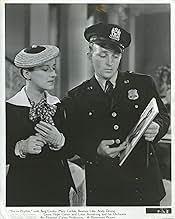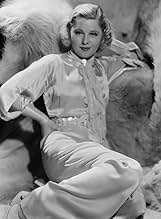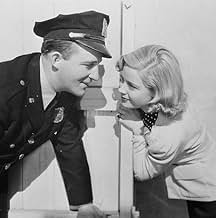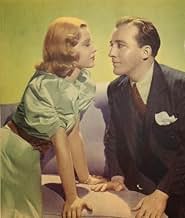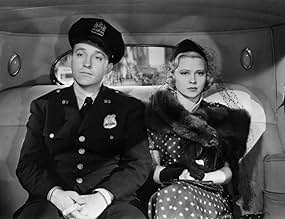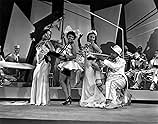अपनी भाषा में प्लॉट जोड़ेंDr. Bill Remsen pretends to be a policeman, and ends up being assigned to guard Judy Marlowe. Amazingly, he falls in love with her.Dr. Bill Remsen pretends to be a policeman, and ends up being assigned to guard Judy Marlowe. Amazingly, he falls in love with her.Dr. Bill Remsen pretends to be a policeman, and ends up being assigned to guard Judy Marlowe. Amazingly, he falls in love with her.
- पुरस्कार
- कुल 3 जीत
फ़ीचर्ड समीक्षाएं
Back in 1938 Gonzaga University which Bing Crosby attended, but never graduated from, decided to honor their most famous student with an honorary doctorate. For several weeks on Bing's Kraft Music Hall, guests and cast member ribbed him unmercifully about the degree and called him Doctor Crosby. So coincidentally when Paramount adopted and updated the O Henry story, The Badge of Patrolman O'Roon which is about a doctor and a policeman exchanging jobs, it seemed a natural to get doctor into that title somewhere.
Bing plays Doctor Bill Remsen who due to some hilarious circumstances has to exchange jobs with friend NYPD patrolman Larry O'Roon for the day. O'Roon is played by Andy Devine and his assignment for the day is to bodyguard heiress Mary Carlisle. Mary has a ditzy aunt who is played by Beatrice Lillie in one of her very few screen appearances.
Since this a Bing Crosby Paramount picture in the late 1930s, I suppose you can say that Bea Lillie's function her is to be the comic female like Martha Raye had previously served. But she was far more than that. One of the great stage acts in both Europe and America, Bea Lillie's comedy could be best described as a sort of sophisticated slapstick. Movie audiences in the those red states never quite took to her, but thank God that Doctor Rhythm preserves the artistry of a very great talent.
Bea Lillie has several high points, her famous double damask dinner napkins routine with Franklin Pangborn, her tilt a whirl in Doctor Remsen's medical office with Andy Devine and finally her Only A Gypsy Knows Number with Crosby in support. Support is not something Bing did in his films, but he does so here and gladly. Bing respected Bea Lillie's talent a great deal and had her as a guest on his radio program a few times over the years.
Louis Armstrong was supposed to be in Doctor Rhythm, but Paramount in regard to southern racial feelings unfortunately cut his numbers out of the film.
Mary Carlisle did her third and last film with Bing Crosby tying her with Martha Raye for second most appearances by a female performer in a Crosby film. Only Dorothy Lamour with all those Road picture credits and Dixie appeared in more.
The rest of the cast fills their roles out nicely. Bing was given three songs to sing, My Heart Is Taking Lessons, On the Sentimental Side, and This Is My Night To Dream by Jimmy Monaco and Johnny Burke. The first song was the one that became the hit from Doctor Rhythm.
A nice bill of health for Doctor Crosby er Rhythm.
Bing plays Doctor Bill Remsen who due to some hilarious circumstances has to exchange jobs with friend NYPD patrolman Larry O'Roon for the day. O'Roon is played by Andy Devine and his assignment for the day is to bodyguard heiress Mary Carlisle. Mary has a ditzy aunt who is played by Beatrice Lillie in one of her very few screen appearances.
Since this a Bing Crosby Paramount picture in the late 1930s, I suppose you can say that Bea Lillie's function her is to be the comic female like Martha Raye had previously served. But she was far more than that. One of the great stage acts in both Europe and America, Bea Lillie's comedy could be best described as a sort of sophisticated slapstick. Movie audiences in the those red states never quite took to her, but thank God that Doctor Rhythm preserves the artistry of a very great talent.
Bea Lillie has several high points, her famous double damask dinner napkins routine with Franklin Pangborn, her tilt a whirl in Doctor Remsen's medical office with Andy Devine and finally her Only A Gypsy Knows Number with Crosby in support. Support is not something Bing did in his films, but he does so here and gladly. Bing respected Bea Lillie's talent a great deal and had her as a guest on his radio program a few times over the years.
Louis Armstrong was supposed to be in Doctor Rhythm, but Paramount in regard to southern racial feelings unfortunately cut his numbers out of the film.
Mary Carlisle did her third and last film with Bing Crosby tying her with Martha Raye for second most appearances by a female performer in a Crosby film. Only Dorothy Lamour with all those Road picture credits and Dixie appeared in more.
The rest of the cast fills their roles out nicely. Bing was given three songs to sing, My Heart Is Taking Lessons, On the Sentimental Side, and This Is My Night To Dream by Jimmy Monaco and Johnny Burke. The first song was the one that became the hit from Doctor Rhythm.
A nice bill of health for Doctor Crosby er Rhythm.
My wife and I saw Dr. Rhythm when we were first married about 40 years ago. We loved it and never forgot the main song, nor Beatricy Lillie driving Franklin Pangborn crazy over the danner nipkins. For the last 20 years or so we've tried unsuccessfully to get a copy. Turner doesn't even list it. Other posters here also remember it fondly, hoping to see it again. Good news! As of January 2013 the entire film is posted on YouTube. We just watched it and it was as good as we remembered. The songs are pleasant, the actors are old favorites, including Andy Devine and Sterling Holloway. The action is unexpected and well paced. The comedy is unforced and genuine. Bea Lillie steals the show whenever she appears. Indeed, she should have received equal billing with Crosby. Why not? Only a gypsy knows!
Singing doctor Bing Crosby -- I hope he's not a proctologist -- helps out enfeebled friend cop Andy Devine. He rents a uniform and takes his place, assigned to Beatrice Lillie. Her niece, Mary Carlisle, wants to elope with Fred Keating. Miss Lillie is too busy singing quodlibets, trying to buy dinner napkins, and roller-skating at a police benefit, so Crosby must forestall the younger woman.
Director Frank Tuttle expertly referees this mishmosh, with Crosby singing two solos and a duet with Miss Lillie, Keating performing a magic trick -- he was a stage magician before turning actor -- and Miss Carlisle looking pretty. Miss Lillie, of course, steals every scene she's in, repeating some of her stage routines, and holding her own against such expert farceurs as Laura Hope Crewe, Franklin Pangborn, and Sterling Holloway. The copy I looked at did not include the Louis Armstrong number, but Bing played second banana in his starring role, and liked it. As did I.
Director Frank Tuttle expertly referees this mishmosh, with Crosby singing two solos and a duet with Miss Lillie, Keating performing a magic trick -- he was a stage magician before turning actor -- and Miss Carlisle looking pretty. Miss Lillie, of course, steals every scene she's in, repeating some of her stage routines, and holding her own against such expert farceurs as Laura Hope Crewe, Franklin Pangborn, and Sterling Holloway. The copy I looked at did not include the Louis Armstrong number, but Bing played second banana in his starring role, and liked it. As did I.
"Doctor Rhythm" (Paramount, 1938), directed by Frank Tuttle, based upon a story, "The Badge of Policeman O'Roon" by O. Henry, is a lightweight musical-comedy starring Bing Crosby, a movie that seems to be best remembered today solely for its "Double Dasmisk Dinner Napkins" routine featuring none other than comedienne Beatrice Lillie (1894-1989) in a very rare screen appearance during Hollywood's Golden Age. And she is not only very funny, but a bizarre personality who seems to be an unlikely performer to be featured in a Bing Crosby musical.
The story opens at Central Park when four alumni of Public School 43 of Brooklyn, N.Y., meet at midnight (?) for their annual reunion. The four men are Luke (Sterling Holloway), an ice cream salesman; Al (Rufe Davis), a zoo keeper; Larry O'Roon (Andy Devine), a policeman; and Doctor William Remsen (Bing Crosby), getting together, and singing the film's first tune, "P.S. 43." Because O'Roon gets nice and drunk and is unable to go on duty the following morning, Remsen decides to take his place for the day, assuming the assignment as a bodyguard to a spoiled heiress named Judy Marlowe (Mary Carlisle), engaged to a phony, Chris LeRoy (Fred Keating) who not only has a questionable past, but is only after her money. Of course, she's unaware of his scheme. After a love-hate relationship between Remsen and Judy, the thin storyline concludes with a policeman's benefit supported by Lorelei Dodge-Blodgett (Bea Lillie) who not only MC's on stage wearing roller skates, but performs in an opera burlesque number titled "Only a Gypsy Knows."
Other songs by Johnny Burke and Jimmy Monaco include: "My Heart is Taking Lessons" (sung by Crosby); "Rhythm" (sung by Bea Lillie); "On the Sentimental Side" "On the Sentimental Side" (reprise); "My Heart is Taking Lessons," "This Is My Night to Dream" (this nice sentimental tune sung by Crosby to Carlisle in the tunnel of love sequence); and "My Heart is Taking Lessons" (sung by Crosby and cast). Although I find many of the songs quite listenable, they are virtually forgotten today.
The supporting players include Franklin Pangborn and William Austin, character actors who partake in the "Double Dasmisk Dinner Napkins" routine; Laura Hope Crews, John Hamilton (the one and only Perry White of the "Superman" TV series of the 1950s) and Henry Wadsworth as Otis. As for blonde and pert Mary Carlisle, she makes her third and final appearance opposite Crosby.
Like many other musicals of the 1930s, "Doctor Rhythm" is just an excuse to have Bing Crosby going through 80 minutes or so of silly plot and introducing several tunes with a songwriter's hope that one of them will end up on the Hit Parade charts before rapping it all up in the end. While no masterpiece, "Doctor Rhythm" is a real curio, and a film's buff's dream to have it resurface again on television or video. (***)
The story opens at Central Park when four alumni of Public School 43 of Brooklyn, N.Y., meet at midnight (?) for their annual reunion. The four men are Luke (Sterling Holloway), an ice cream salesman; Al (Rufe Davis), a zoo keeper; Larry O'Roon (Andy Devine), a policeman; and Doctor William Remsen (Bing Crosby), getting together, and singing the film's first tune, "P.S. 43." Because O'Roon gets nice and drunk and is unable to go on duty the following morning, Remsen decides to take his place for the day, assuming the assignment as a bodyguard to a spoiled heiress named Judy Marlowe (Mary Carlisle), engaged to a phony, Chris LeRoy (Fred Keating) who not only has a questionable past, but is only after her money. Of course, she's unaware of his scheme. After a love-hate relationship between Remsen and Judy, the thin storyline concludes with a policeman's benefit supported by Lorelei Dodge-Blodgett (Bea Lillie) who not only MC's on stage wearing roller skates, but performs in an opera burlesque number titled "Only a Gypsy Knows."
Other songs by Johnny Burke and Jimmy Monaco include: "My Heart is Taking Lessons" (sung by Crosby); "Rhythm" (sung by Bea Lillie); "On the Sentimental Side" "On the Sentimental Side" (reprise); "My Heart is Taking Lessons," "This Is My Night to Dream" (this nice sentimental tune sung by Crosby to Carlisle in the tunnel of love sequence); and "My Heart is Taking Lessons" (sung by Crosby and cast). Although I find many of the songs quite listenable, they are virtually forgotten today.
The supporting players include Franklin Pangborn and William Austin, character actors who partake in the "Double Dasmisk Dinner Napkins" routine; Laura Hope Crews, John Hamilton (the one and only Perry White of the "Superman" TV series of the 1950s) and Henry Wadsworth as Otis. As for blonde and pert Mary Carlisle, she makes her third and final appearance opposite Crosby.
Like many other musicals of the 1930s, "Doctor Rhythm" is just an excuse to have Bing Crosby going through 80 minutes or so of silly plot and introducing several tunes with a songwriter's hope that one of them will end up on the Hit Parade charts before rapping it all up in the end. While no masterpiece, "Doctor Rhythm" is a real curio, and a film's buff's dream to have it resurface again on television or video. (***)
7tavm
After years of knowing this obscure Bing Crosby movie was on YouTube, I finally decided to watch this just now there. The story is quite a mess concerning Crosby's doctor character switching places with Andy Devine's policeman for reasons I don't feel like revealing here. Also appearing is legendary British stage comedienne Bea Lillie who does her "dinner napkins" routine to hilarious effect with Franklin Pangborn and a few others. She also has another funny one with Devine as the doctor and one with Crosby near the end. She also performs some funny numbers sans Crosby who does his usual love songs to nice effect. In summary, Doctor Rhythm was a funny musical comedy but don't expect it to make too much sense if you want to enjoy it to its fullest...
क्या आपको पता है
टॉप पसंद
रेटिंग देने के लिए साइन-इन करें और वैयक्तिकृत सुझावों के लिए वॉचलिस्ट करें
विवरण
- रिलीज़ की तारीख़
- कंट्री ऑफ़ ओरिजिन
- भाषा
- इस रूप में भी जाना जाता है
- The Badge of Policeman O'Roon
- फ़िल्माने की जगहें
- उत्पादन कंपनी
- IMDbPro पर और कंपनी क्रेडिट देखें
- चलने की अवधि
- 1 घं 20 मि(80 min)
- रंग
- पक्ष अनुपात
- 1.37 : 1
इस पेज में योगदान दें
किसी बदलाव का सुझाव दें या अनुपलब्ध कॉन्टेंट जोड़ें

